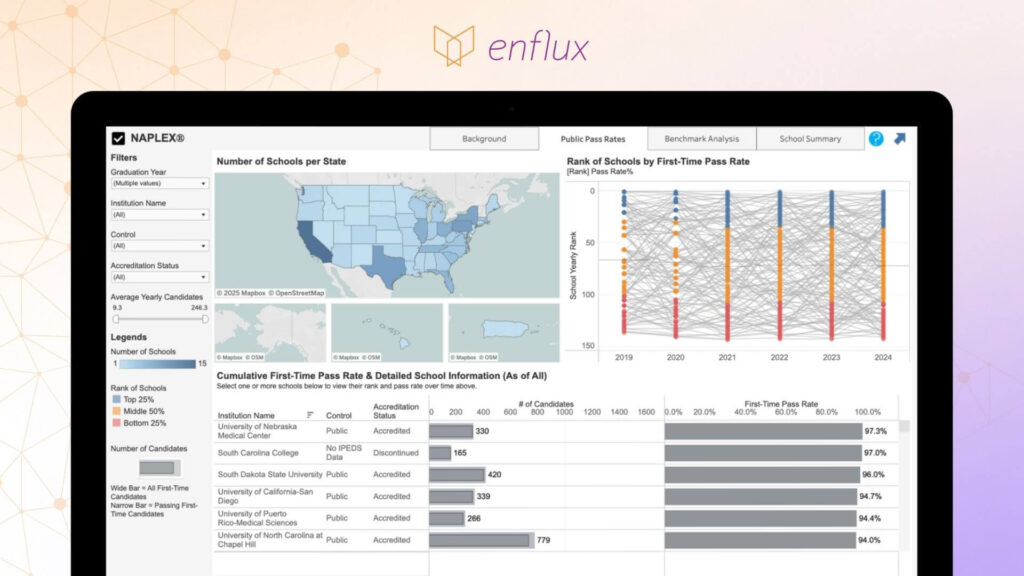
How Pharmacy Analytics Software Helps Map COEPA Competencies and Improve NAPLEX Outcomes
As pharmacy education shifts toward competency-based frameworks, academic institutions face the challenge of systematically aligning student performance with curricular expectations and licensure demands. The integration of pharmacy analytics software into educational practice provides a data-driven mechanism for ensuring that graduates are prepared for the evolving landscape of patient-centered care, professional collaboration, and national licensure standards.
This article explores how pharmacy analytics software for higher education—specifically platforms like Enflux with its CompetencyGenie™ tool, AI-powered solution for category tagging,—supports the rigorous demands of AACP Curriculum Outcomes and Entrustable Professional Activities (COEPA) competencies, enhances The North American Pharmacist Licensure Examination® (NAPLEX®) Competency readiness, and meets the expectations of ACPE Standards 2025.
Competency-based pharmacy education and the role of learning analytics
Contemporary pharmacy programs are increasingly structured around competency-based pharmacy education, a model that demands transparent alignment between curriculum, assessment, and student outcomes. At the heart of this shift are the COEPA, which articulate the domains of performance expected of entry-level pharmacists.
However, operationalizing COEPA across diverse courses, assessments, and student pathways requires more than intent—it requires infrastructure. This is where pharmacy education learning analytics tools play a transformative role.
Learning analytics platforms enable programs to:
- Tag assessments with COEPA-aligned competencies at both the domain and subdomain level.
- Map assessments and instructional content to ACPE Standards 2025, the NAPLEX blueprint, and program-level outcomes.
- Identify areas of strength and weakness across the pharmacy curriculum mapping process.
AI-driven exam tagging across multiple competency frameworks
Assessment alignment is no longer a one-dimensional task. Faculty must often tag individual exam items across overlapping frameworks:
- COEPA domains and EPAs
- ACPE-required didactic standards
- The 2025 NAPLEX Competency Statements
- Institutional learning outcomes
- CAPE outcomes, PPCP steps, and the ACCP Pharmacotherapy Toolkit
On-demand webinar:
To support this complexity, tools like CompetencyGenie™ apply natural language processing to exam item stems, suggesting alignments across these frameworks. This eliminates the burden of manual tagging while retaining faculty oversight.
Case Study
Discover how Florida A&M University College of Pharmacy improved exam tagging and boosted NAPLEX pass rates using a learning analytics platform
Improving NAPLEX readiness with pharmacy learning analytics
The predictive capabilities of pharmacy learning analytics extend beyond tagging. These platforms provide a longitudinal view of student performance, allowing programs to anticipate outcomes and intervene early.
Key functionalities include:
- Predictive modeling to identify students at risk of failing the NAPLEX based on historical and cohort data.
- Targeted remediation plans are derived from analytics dashboards that connect performance to competency gaps.
- Content blueprint analysis based on NAPLEX frequency distributions, ensuring instruction and practice exams focus on the most critical areas.
- Progress monitoring tools that track mastery of individual competencies throughout the didactic and experiential curriculum.
These capabilities not only strengthen individual student outcomes but also contribute to program-level improvements in licensure pass rates.

Quickly do benchmark analysis and see how your school is doing compared to your state and the nation on the NAPLEX® Dashboard.
The 2025 revision of the ACPE Standards requires greater documentation of outcome-based education and continuous quality improvement. For many institutions, static spreadsheets and disconnected assessment systems are no longer sufficient.
By using dedicated pharmacy school accreditation software, like Enflux, programs can:
- Generate real-time reports that demonstrate alignment to COEPA and ACPE standards.
- Visualize curriculum coverage using dynamic real-time dashboards.
- Document the rationale and evidence behind curricular changes.
- Facilitate faculty engagement in assessment and curriculum redesign.
The ability to track pharmacy student performance across competency frameworks is particularly critical in preparing for accreditation visits, self-studies, and external reporting.
A strategic imperative for pharmacy education
By implementing advanced pharmacy education assessment tools like Enflux and CompetencyGenie™, institutions can:
- Achieve transparent pharmacy curriculum mapping across COEPA, NAPLEX, and ACPE standards.
- Strengthen NAPLEX outcomes through early intervention and focused preparation.
- Enhance competency-based pharmacy education using real-time performance analytics.
- Support faculty and leadership in delivering a forward-facing, student-centered educational experience.
In doing so, academic pharmacy programs move from fragmented assessment to data-driven strategic improvement for meeting accreditation standards—empowered by data, grounded in practice, and aligned with the future of the profession.
Improve NAPLEX outcomes with AI-powered pharmacy learning analytics
Map COEPA competencies and align with ACPE 2025 using real-time data and predictive insights